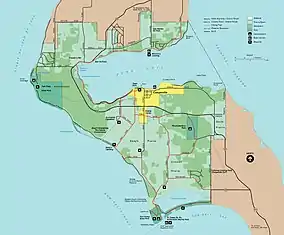Ebey's Landing National Historical Reserve
Ebey's Landing National Historical Reserve is a unit of the National Park Service on Whidbey Island in the Puget Sound, near Coupeville in Island County, Washington, United States.
| Ebey's Landing National Historical Reserve | |
|---|---|
IUCN category V (protected landscape/seascape) | |
 Map of the sites in the reserve. | |
| Location | Island County, Washington, US |
| Nearest city | Coupeville, Washington |
| Coordinates | 48°13′6″N 122°41′1″W |
| Area | 19,333 acres (78.24 km2)[1] |
| Established | November 10, 1978 |
| Governing body | National Park Service |
| Website | Ebey's Landing National Historical Reserve |
Ebey's Landing National Historical Reserve | |
 | |
| NRHP reference No. | 01000229 |
|---|---|
| Added to NRHP | November 10, 1978 |
Central Whidbey Island Historic District | |
 | |
| NRHP reference No. | 73001869 |
|---|---|
| Added to NRHP | December 12, 1973 |

Description
The Ebey's Landing National Historical Reserve is a rural historic district that preserves and protects the historical record of Puget Sound exploration and settlement from the 19th century to the present. Historic farms, still under cultivation in the prairies of Whidbey Island, reveal land use patterns unchanged since settlers claimed the land in the 1850s under the Donation Land Claim Act. The nearby seaport community of Coupeville, one of the oldest towns in Washington, is included in the reserve.
Also included are both Fort Casey State Park and Fort Ebey State Park, as well as a section of the Pacific Northwest National Scenic Trail. The Central Whidbey Island Historic District, with the Sergeant Clark House and the Coupeville grain wharf, is part of the National Historical Reserve and is listed on the National Register of Historic Places.[2] Other protected lands within the reserve include the Admiralty Inlet Natural Area Preserve.
History
The Reserve at Ebey's Landing provides a vivid historical record of Pacific Northwest history, including the first exploration of Puget Sound by Captain George Vancouver in 1792; early settlement by Colonel Isaac Ebey, who filed a claim under the Donation Land Claim Act in 1850;[3] growth and settlement resulting from the Oregon Trail and the Westward migration; the Donation Land Laws (1850–1855); and the continued growth and settlement of the town of Coupeville.
Jurisdictions
Unlike many National Park Service units, the Ebey's Landing National Historical Reserve encompasses a mixture of federal, state, county, and private property.[4] Authorized November 10, 1978, the reserve is a partnership managed by a local trust board. Limited federal facilities exist in the reserve, and only 209.06 acres (0.846 km²) of the reserve are federally owned.
See also
References
- "Listing of acreage – December 31, 2011" (XLSX). Land Resource Division, National Park Service. (National Park Service Acreage Reports)
- Cathy Gilbert; Gretchen Luxenberg (December 1997). "National Register of Historic Places Inventory – Nomination Form: Central Whidbey Island Historic District" (PDF). National Park Service. Retrieved December 9, 2015. Accompanying photos.
- Washington (State). Office of Archaeology and Historic Preservation. (1989). Built in Washington : 12,000 years of Pacific Northwest archaeological sites and historic buildings. Pullman, Wash.: Washington State University Press. p. 47. ISBN 0874220653. OCLC 20421846.
- Roberts & Roberts 1999, p. 171
Sources
- Roberts, George; Roberts, Jan (1999). Discover historic Washington State. Baldwin Park, CA: Gem Guides Book Co. ISBN 1-889786-07-1.
- The National Parks: Index 2001–2003. Washington: U.S. Department of the Interior.
External links
Ebey's Landing National Historical Reserve.

